|
This species has been introduced into California. It is not a native species.
|
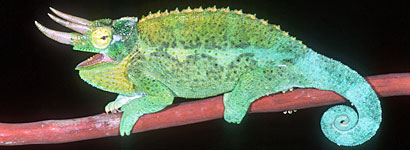 |
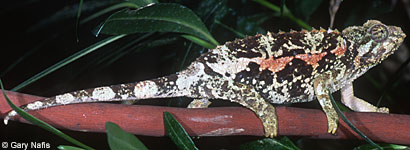 |
 |
 |
Adult male, Morro Bay, San Luis Obispo county © Gary Nafis,
specimen courtesy of Steven Boone & Joe Cirone |
Adult female, Morro Bay, San Luis Obispo county © Gary Nafis,
specimen courtesy of Steven Boone & Joe Cirone |
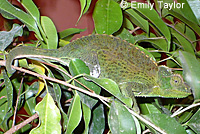 |
|
More pictures of Jackson's Chameleons found in California can be seen on the
H. E. R. P. database and on iNaturalist. |
|
| Adult female, Morro Bay. © Emily Taylor |
|
|
|
| |
|
|
|
| Wild Jackson's Chameleon From Hawaii |
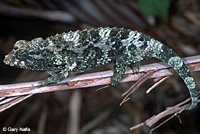 |
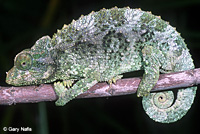 |
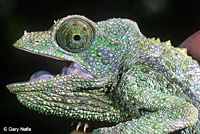 |
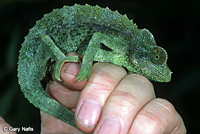 |
Adult female, 1,600 ft., Maui, Hawaii.
Notice the color variation in these pictures of the same lizard taken within 20 minutes, with the first on the left and the last on the right. |
| |
| Habitat |
 |
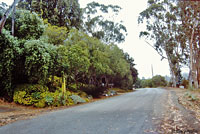 |
|
|
| A foggy summer morning in Morro Bay, San Luis Obispo County |
Chameleons have been found on this property and similar residential areas around Morro Bay. |
|
|
| |
|
|
|
| Description - based primarily on McKeown, 1996 |
| |
| Size |
Average snout-to-vent length 4 3/4 - 5 inches ( 12.1 - 12.7 cm).
Average total length is 10 inches (25.4 cm).
|
| Appearance |
A large, thick-bodied lizard, able to rapidly change color.
Large eyes are able to move independently of each other, and are set on turrets, allowing them to move around in a circle which enables a chameleon to see in any direction.
The tail is prehensile, aiding a lizard in climbing.
When not in use, the tail is coiled.
The tongue is hollow and extremely long - more than the length of the entire body.
It is rapidly shout out of the mouth by muscular contractions to grab at prey with its sticky tip. |
| Color and Pattern |
| Coloring includes yellow, blue, brown, gray, charcoal, black, and many shades of green. |
| Male / Female Differences |
Males and females are different in appearance.
Males have three horn-like projections at the front of the head.
Females lack these horns.
|
| Life History and Behavior |
Activity |
Arboreal - living in trees and bushes.
Opposable toes on all four feet allow sure footing, and a prehensile tail aids in climbing.
Changes color in response to interaction with other chameleons, light, temperature, response to threats, and activity.
|
| Territoriality |
Males use horns to spar for territory or breeding rights.
The losing male is pushed off a limb and forced to retreat. |
| Defense |
| Chameleons will flatten the body or make it appear thinner to hide by blending in with the foliage. |
| Diet and Feeding |
| Eats a variety of small invertebrates. |
| Reproduction |
A male will approach a female, bob his head side to side, and show yellow and blue coloring.
The female will indicate her readiness to mate by turning solid green.
If not, she will show stress coloring, including large areas of black, and she will hiss and bite.
Young are born live, encased in a membrane, after a 5 to 6 month gestation period.
During birth, the female sits at an elevated location and drops each newborn to the ground which stimulates it to emerge from its membrane.
Anywhere from 5 - 50 young are born.
Young are ready to feed within hours of birth.
|
| Habitat |
In California, this lizard seems to have adapted to vegetation around human settlements along the coast where the combination of fog and sunshine provide it with the necessary temperature and moisture requirements.
It appears that this lizard is in danger of desiccation from dry environments.
|
| Geographical Range |
Native to humid cool areas of Kenya and Tanzania in East Africa, especially at altitudes of over 3,000 meters (9842 ft..)
Range in California
Established in San Luis Obispo and Orange Counties. (May not be established in both locations now.)
Possibly established in San Diego and Los Angeles Counties.
Locations include Morro Bay, Laguna Beach, and possibly the Palos Verde Peninsula and Balboa Park.
(McKeown, Bulletin of the Chicago Herpetologial Society 32:101. 1997)
Origin of the Morro Bay Population
I have received personal communications regarding the origin of the established population of non-native Jacksons chameleons in Morro Bay from more than one source, with the same facts, so I believe the story is accurate. The chameleons were released by California Department of Fish and Game employees when they left the door open to a chameleon cage during a raid on a man suspected of selling prohibited reptiles in Morro Bay in 1981. It is assumed that the employees did not see the lizards in the cage and 10 chameleons accidentally escaped into the wild. It is not known how many male and how many female chameleons escaped. After dispersing they found the habitat favorable and eventually began breeding.
|
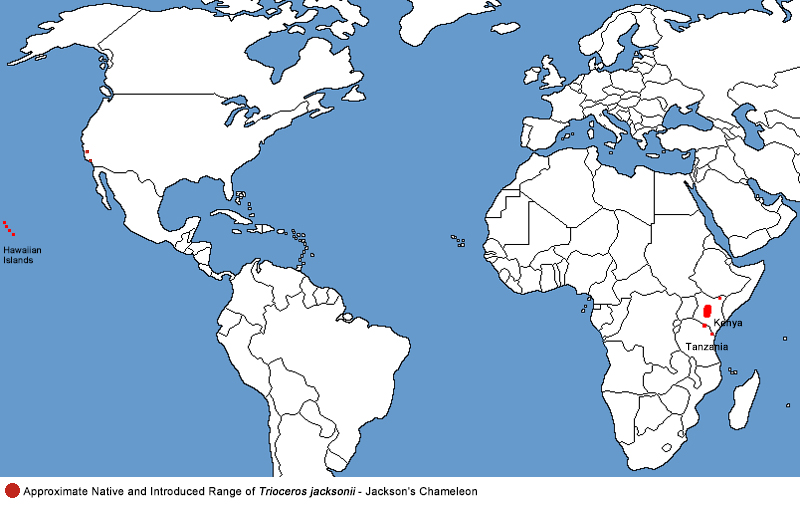
|
| Notes on Taxonomy |
Formerly known as Chamaeleo jacksonii.
Trioceros was previously considered a subgenus of the genus Chamaeleo until 2009 when it was elevated to full genus level. (Wikipedia 6/18)
|
| Conservation Issues (Conservation Status) |
| It is not evident how competition from this introduced species impacts native species, but the spread of this or any non-native species should be discouraged. |
|
|
Taxonomy |
| Family |
Chamaeleonidae |
Chameleons |
Gray, 1825 |
| Genus |
Trioceros |
Chameleons |
Swainson, 1839 |
Species
|
jacksonii |
Jackson's Chameleon |
Boulanger, 1896 |
|
Original Description |
Chamaeleo jacksonii Boulenger, 1896 : Jackson's Chameleon
|
|
Meaning of the Scientific Name |
The name "chameleon" means, "Earth lion" and is derived from the Greek words "chamai" (on the ground, on the earth) and "leon" (lion).
(From Wikipedia)
Trioceros - "three horns" - from Greek - "tri" = "three" and "keras" = "horns."
Eponyms
First described by Belgian-British zoologist George Albert Boulenger in 1896, the specific name "Triceros jacksonii" and the common name "Jackson's Chameleon" honor Frederick John Jackson (1859-1929) an English explorer, ornithologist, and the Governor of Kenya a the time where the chameleon originated.
Biographical detail can be found in 'Whose Bird?' by Bo Beolens & Michael Watkins, 2003, Christopher Helm, London (The authors are working on a similar eponym dictionary for reptiles and amphibians that will be published in approximately 2011.)
|
|
Alternate Names |
Chamaeleo jacksonii - Jackson's Chameleon
Jackson's Horned Chameleon
Kikuyu Three-Horned Chameleon
Some sources identify these introduced lizards as the subspecies:
Yellow-crested Jackson's Chameleon - Chamaeleo jacksonii xantholophus Eason, Ferguson & Hebrard 1988
|
|
Related or Similar California Lizards |
None
|
|
More Information and References |
California Department of Fish and Wildlife
Hansen, Robert W. and Shedd, Jackson D. California Amphibians and Reptiles. (Princeton Field Guides.) Princeton University Press, 2025.
Stebbins, Robert C., and McGinnis, Samuel M. Field Guide to Amphibians and Reptiles of California: Revised Edition (California Natural History Guides) University of California Press, 2012.
Stebbins, Robert C. California Amphibians and Reptiles. The University of California Press, 1972.
Flaxington, William C. Amphibians and Reptiles of California: Field Observations, Distribution, and Natural History. Fieldnotes Press, Anaheim, California, 2021.
Nicholson, K. E. (ed.). 2025. Scientific and Standard English Names of Amphibians and Reptiles of North America North of Mexico, with Comments Regarding Confidence in Our Understanding. Ninth Edition. Society for the Study of Amphibians and Reptiles. [SSAR] 87pp.
Stebbins, Robert C. A Field Guide to Western Reptiles and Amphibians. 3rd Edition. Houghton Mifflin, 2003.
McKeown, Sean. A Field Guide to Reptiles and Amphibians in the Hawaiian Islands. Diamond Head Publishing, Inc. 1996.
|
|
|
The following conservation status listings for this animal are taken from the July 2025 State of California Special Animals List and the July 2025 Federally Listed Endangered and Threatened Animals of California list (unless indicated otherwise below.) Both lists are produced by multiple agencies every year, and sometimes more than once per year, so the conservation status listing information found below might not be from the most recent lists, but they don't change a great deal from year to year.. To make sure you are seeing the most recent listings, go to this California Department of Fish and Wildlife web page where you can search for and download both lists:
https://www.wildlife.ca.gov/Data/CNDDB/Plants-and-Animals.
A detailed explanation of the meaning of the status listing symbols can be found at the beginning of the two lists. For quick reference, I have included them on my Special Status Information page.
If no status is listed here, the animal is not included on either list. This most likely indicates that there are no serious conservation concerns for the animal. To find out more about an animal's status you can also go to the NatureServe and IUCN websites to check their rankings.
Check the current California Department of Fish and Wildlife sport fishing regulations to find out if this animal can be legally pursued and handled or collected with possession of a current fishing license. You can also look at the summary of the sport fishing regulations as they apply only to reptiles and amphibians that has been made for this website.
This animal is not included on the Special Animals List, which indicates that there are no significant conservation concerns for it in California.
|
| Organization |
Status Listing |
Notes |
| NatureServe Global Ranking |
|
|
| NatureServe State Ranking |
|
|
| U.S. Endangered Species Act (ESA) |
None |
|
| California Endangered Species Act (CESA) |
None |
|
| California Department of Fish and Wildlife |
None |
|
| Bureau of Land Management |
None |
|
| USDA Forest Service |
None |
|
| IUCN |
|
|
|
|
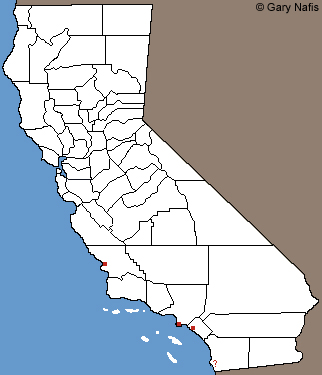 Red: Locations where this non-native species has been
Red: Locations where this non-native species has been 












